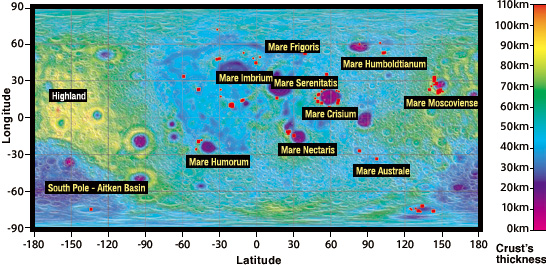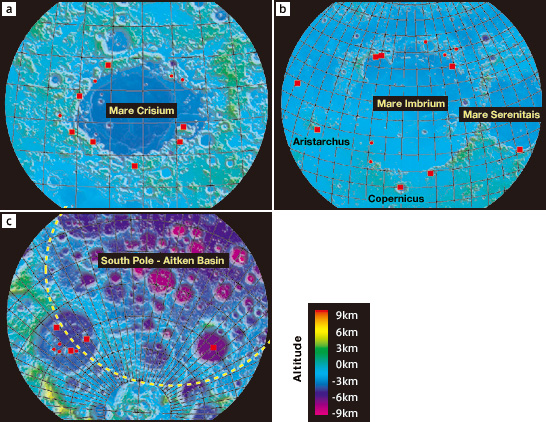TOP > Report & Column > The Forefront of Space Science > 2010 > Lunar Interior Material Revealed by KAGUYA
![]()

Since we expected that the spectrum of pure olivine is contained in the SP data, we analyzed all the retrieved data paying careful attention to the absorption band of center wavelength 1.05µm specific to olivine. As a result, data having such a band accounted for about 250 out of 70 million data (Fig. 2). The ratio of 250 for 70 million data is only 0.0004%. This means that pure olivine is present in extremely limited places on the lunar surface. 
After further analysis, it was revealed that most of the 250 data were associated with small craters with a diameter of 1km to 10km. After categorizing the data according to local geologic context, olivine-rich material was found in 34 locations. Three of these 34 locations had been reported in the past, which means that 31 new locations were revealed by the SP. On the other hand, it was reported that the U.S. lunar explorer Clementine had discovered olivine in the central peak of six craters. However, since Clementine was unable to measure the wavelength region longer than 1µm, the crucial range to identify olivine, it was confirmed by SP that five out of six sites were erroneous. All the 34 olivine-rich sites are situated near the blue-to-purple regions in Fig. 2, where the crust is thin. These thin-crust areas correspond to giant impact basins (also called ďlunar mariaĀE, which were formed by the impact of huge meteorites 3.8 to 4.0 billion years ago. Meanwhile, no olivine-rich material was discovered in the thick-crust areas called lunar highland in the far side of the Moon. Further study of the giant-impact basins indicates that olivine-rich sites are distributed around the basins (Fig. 3). In the Mare Crisium, for example, you can see olivine-rich locations distributed along the rim of the basin. However, olivine-rich sites are not found in the center of the Mare or far from the rim of the basin. The same feature was also observed at other giant-impact basins. It was also revealed that sites where the existence of olivine was reported in the past (e.g., Copernicus and Aristarchus Craters in Fig. 3 (b)) are similarly located in the region circling the basin called the Mare Imbrium. It was expected that olivine from the lunar mantle would be distributed in the South Pole-Aitken Basin, since it is a huge basin 2,600km in diameter. Nonetheless, no olivine-rich site had been discovered in past observations. The SP, however, discovered olivine-rich sites around the basinís rim. In addition, our SP research discovered a layer of orthopyroxene (another silicate mineral) under the ground at the center of the South Pole- Aitken Basin. This orthopyroxene is thought to originate from material that melted at impact during the basinís formation. We guess that olivine-rich material is not found in the central area of the basin because the higher-density, mantle-originated olivine sank deeper than the lower-density orhtopyroxene that formed a layer above it. Thus, it was concluded that olivine-rich sites were distributed only around rim areas of giant impact basins on thin-crust regions of the Moon. How was such an unevent distribution pattern created? 
|
||||||||||




